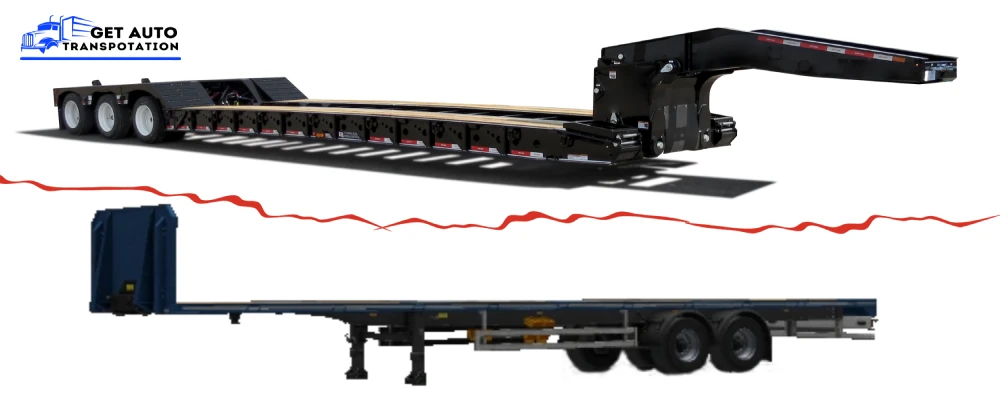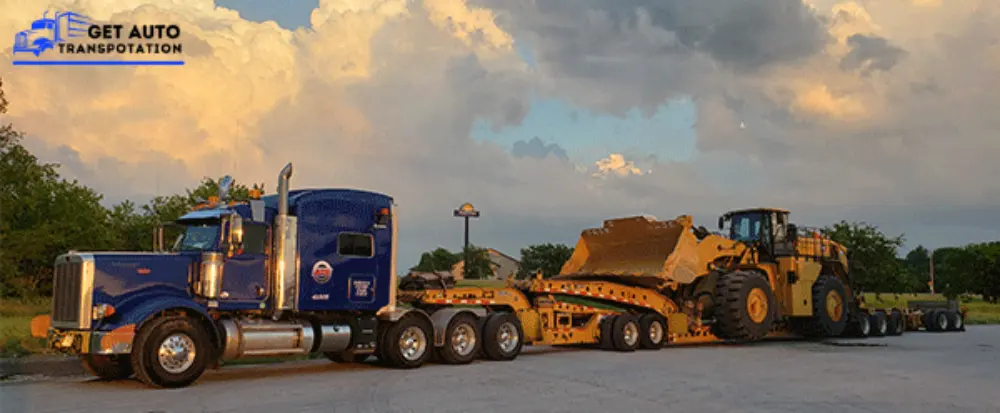Numbers Speaks Louder Than words
Exact 0 Scratch Deliveries
Years Of Experience
Trailer Available
Quote Provided
(14,534 reviews)
(3534 reviews)
(7534 reviews)
(6634 reviews)
What's In This Article?
- When and Where are Lowboys Used?
- What are the Differences between Lowboy and Standard Trailers?
- How Many types of Lowboy Trucking?
- How does Using a Lowboy Impact Your Rate or Prices?
- What are the Advantages of a Heavy Haul Lowboy Trailer?
- Why do You Choose Get Auto Transportation Lowboy Trucking Services?
When and Where are Lowboys Used?
As mentioned, lowboy trailers are commonly used to carry heavy or oversized loads. They are commonly used to transport construction equipment and bulky items throughout the United States. Since they are used to transport such heavy and oversized loads, extra safety considerations must be considered when using lowboy trailers. Although a standard two-axle lowboy can haul up to 40,000 pounds, you can reach a carrying capacity of up to 80,000 by adding the correct number of axles.
Extra protection considerations when using Lowboy Trailers
What are the Differences between Lowboy and Standard Trailers?
While a lowboy trailer and a standard trailer may look the same to an untrained eye, there are some key differences to consider. truck lowboy trailer is, Most obviously, lower to the ground than standard trailers.
As a result, they can carry loads up to 12-feet high. In addition, lowboys come with a double-level drop system wherein they have two drops in deck height rather than a standard height across the whole length of the carrier.
shipping-form-state-image
How Many types of Lowboy Trucking?
Here are three different types of Lowboy Trucking:
You want to know about the three types of lowboy semi trailer: fixed neck lowboys, fixed gooseneck lowboys, and removable gooseneck lowboys. Let’s explore each one in greater detail to give you a comprehensive understanding of Get Auto Transportation lowboy hauling near me:
Fixed Gooseneck Lowboy
The Lowboy trailer's superior type is the fixed gooseneck lowboy. Also known as a fixed gooseneck, this type of trailer is lightweight and has a longer deck length.
Since it is a lowboy, a fixed gooseneck is low to the ground and usually has drop ramps in the back for quick and easy equipment loading.
Fixed Neck Lowboy
The lowboy trailer's next type is the fixed-neck lowboy. This type of trailer has a fixed neck, making it difficult to load from the front since it cannot be detached for easy loading. Still , it does offer the most lightweight.
Removable Gooseneck Lowboy
The lowboy trailer's last type is the removable gooseneck lowboy. Also known as a removable gooseneck, this type of trailer has a shorter deck length. The gooseneck can be quickly and easily detached thanks to a hydraulic system that can raise and lower the trailer on demand. A removable gooseneck is ideal for driving, rolling, pushing, or pulling the equipment onto the trailer bed.
How does Using a Lowboy Impact Your Rate or Prices?
Lowboy trailers, particularly lowboy removable goosenecks, are more specialized equipment than your traditional step deck trailer. As such, the drivers pulling these trailers must be more experienced in shipping more significant freight and the processes accompanying doing so.
Using these trailers correctly and securing the freight on their bed can sometimes be far more intricate than other equipment types. That's why you should expect to pay more to move a commodity requiring a lowboy trailer rather than a step deck.
What are the Advantages of a Heavy Haul Lowboy Trailer?
Get Auto Transportation explores a lowboy trailer's advantages and most important role in modern logistics.
Enhanced load flexibility and capacity:
This feature is particularly beneficial when moving construction machinery, industrial equipment, and other large cargo items. The low profile of the trailer ensures that taller equipment can be transported safely and without disassembly, minimizing downtime and labor costs.
A lowboy trailer's essential pros are its exceptional flexibility and load capacity. Lowboy trailers are designed with a low bed height and a dropped deck, which are heavier loads and allow them to accommodate taller ones that would otherwise be challenging to transport using standard trailers.

Easy loading and unloading
Load and unload heavy equipment can be a time-consuming and complex process. Lowboy trailers simplify this task with their detachable gooseneck design. The front section of the trailer can be detached, allowing equipment to be driven or rolled onto the deck. This feature streamlines the loading and unloading process, eliminating the need for specialized loading equipment and reducing the overall handling time.
Cost-effective
While heavy haul lowboy trailers offer specialized features and capabilities, they also contribute to cost efficiency in the long run. Transporting taller and heavier loads without disassembly reduces labor and equipment costs. Lowboy trailers' enhanced stability and maneuverability can also lead to fewer accidents or damages during transit, saving on potential repair expenses.
Overpasses and Height Clearance for Bridges
Transporting oversized cargo often requires careful consideration of height clearance for bridges and overpasses along the route. The lowered deck height of Lowboy trailers ensures that the cargo remains within permissible height limits, minimizing the need for detours or route adjustments. This advantage contributes to smoother and more efficient transportation, reducing delays and logistical challenges.
Maneuverability and Stability improved
Lowboy trailers are engineered for stability and maneuverability, making them reliable for transporting heavy and oversized loads. The design of the removable lowboy trailer, with its lower center of gravity, enhances stability during transit. It is imperative when navigating uneven, tight corners, terrains, or steep gradients. The trailer’s hydraulic suspension system further improves ride quality and stability, reducing the risk of load shifts or accidents.
Why do You Choose Get Auto Transportation Lowboy Trucking Services?
Now that you know that we have different types of lowboy trailers, it’s time to move on to other specifications, including materials, suspension options, tires, carrying capacities, and hydraulics.
Let’s explore each component in detail so that you can choose Get Auto Transportation lowboy trailer to meet your hauling needs:
Suspension Options
Several different suspension options exist for a lowboy trailer, including mechanical, rigid, air ride, and single-point suspensions. There are also advantages and disadvantages to each of these options on a similar note.
Mechanical suspensions are an excellent option for heavy-duty trailers as they are highly stable and offer consistent load distribution. This type of suspension is easy to maintain and is inexpensive and reliable.
Rigid suspensions are an excellent option for low-speed transportation of heavy-duty trailers. This is because, with a rigid suspension system, one wheel's movement depends on the other wheel's movement. While this type of suspension is inexpensive and easy to maintain, it has a poor damping effect and doesn’t allow the driver to adjust the ride height for empty or loaded trailers.
This is because air ride suspensions are lighter, more flexible, and more stable. They also lead to less wear and tear on the trailer since there’s less vibration. Still, all of the advantages of air ride suspensions often come at a higher price than other suspension systems.
Finally, single-point suspensions are an excellent option for trailers carrying heavy cargo over 100 tons of weight. This type of suspension system will cost you a pretty penny but may save you money by reducing wear and tear on the trailer, thanks to decreased vibrations.
Carrying Capacity
lowboy trucking typically have to carry capacities of either 25 tons (49,999 pounds) or 35 tons (69999 pounds). It is essential to note that the carrying capacity does not solely refer to the weight of the load carrier.
Instead, carrying capacity refers to the weight of the trailer itself and the weight of the load. For this reason, it’s essential to consider the weight of the trailer and the weight of the intended cargo when choosing the carrying capacity.
Material
Lowboys must be made of a strong material that can withstand equipment and heavy machinery transportation without breaking or bending. There are typically two material options available for lowboys: aluminum and steel. There are pros and cons of each option.
Aluminum may be lightweight and rust-resistant, but it has a lower yield strength and costs more. Based on this information, an aluminum lowboy may be used to transport cargo that’s under 50 tons in weight. On the other hand, steel is more robust, heavier, and ideal for transporting heavy loads over 50 tons.
Tires
There are two types of tires: Get Auto Transportation lowboy trailer, tubeless tires and tube tires. Tube tires are suitable for heavy loads since they are pressurized. Although they are more prone to blowouts and have a shorter service life, they are easy to repair when needed.
On the other hand, you have tubeless tires that are suitable for lighter loads since they are unpressurised. Still, they are not suitable for rough terrains. Tubeless tires are less likely to blow out in the event of a puncture, have a long service life, and have good wear resistance. That being said, they can be more challenging to repair.
Hydraulic or Mechanical
heavy haul lowboy trailers either come with a mechanical gooseneck or a hydraulic. While hydraulic systems are more accessible to operate, they are heavier and more expensive.
On the other hand, mechanical systems are more complex to operate but are lighter, cheaper, and require less maintenance than hydraulics. Generally, most operators choose hydraulics for their ease of use.
We Understand that you love your Car so do we love our
Car
transportation work.
Feel Free to call us or get the shipment booked right away

0 (2) (1).webp)

.webp)

.webp)